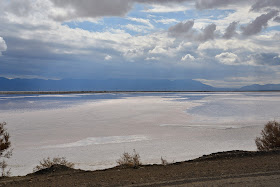We read about Oolitic Sand on the Utah Geology website. It is sediment formed similarly to
cave pearls, which we became interested in at
Carlsbad Caverns. Oolitic sand starts with a tiny bit of sediment that, as it's tossed around in the water, becomes coated with minerals precipitated out of the water. As it continues to move around in the water, the minerals form around it layer upon layer, until it becomes a little round "egg" of mineral-coated sediment. (
This explains it better.) At first glance it doesn't, actually, look that different from normal sand (at least not the stuff here at the Salt Lake), but under a magnifying glass or microscope it's pretty cool. Like tiny round pearls!
It was a really cold, windy day when we took this field trip, but the dark sky and clouds made the desert landscape seem really cool. We felt like we were on another planet or something (the salt desert always makes me feel that way).
Before you reach the dune area, you pass by lots of shallow lake pools, and you can see salt crystals concentrated on the sides of these pools. On a sunny day they really shine.
Another cool thing about going out to Stansbury Island is that you get to go close to the salt concentrating and crystallizing ponds (I think they're for
Morton Salt Company, but there may be other companies working there as well). You can also see the huge piles of white salt glistening in the sun, and big dump trucks going back and forth loaded with salt in their beds. It's really cool.
To find the oolitic sand, we followed the directions
here. [There is also Oolitic Sand on Antelope Island and other shores of the lake, I believe.] The directions were easy to follow, except that where they say "
Travel about 6 miles on this main road until you reach an intersection with a stop sign on the west side of Stansbury Island"--- there is no stop sign at that intersection (anymore?). It's pretty clear that it's the right place, though, because it's the only place there's an intersecting road at all. It's also a little confusing that it refers to a "sandy dune area" if you're expecting large, rolling dunes. These are small sand dunes dotted with plants, like this:
Doesn't it look like another planet?
These little pointy things were so interesting. They were all over on one side of the road, and on closer investigation each one hid some kind of plant or shrub stem (?)---like this:
I don't know what they were!
Small boy all alone in the harsh world
The sand clumped together in these hard, rock-like pieces. You could crumble them pretty easily but if you were careful, you could just pry them up from the ground in sheets like this. The little round oolites are pretty apparent when you look closely!
After we had collected some oolitic sand, we stopped to look at salt crystals too. We loved walking around on the salt flat areas! And we loved the smell of salt in the air.
Every time the sun peeked through the clouds, the effect was dazzling!
And as a bonus, on the way home we got to pass by the huge smokestack that the children all love so much---Abe got a picture of it! :)



























































